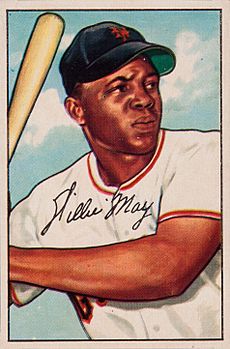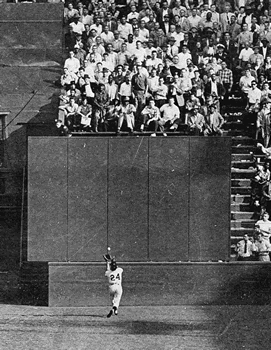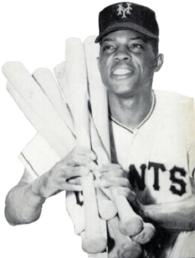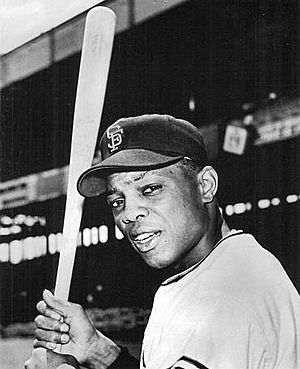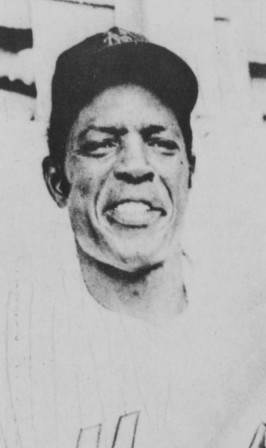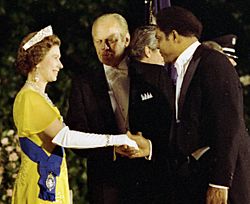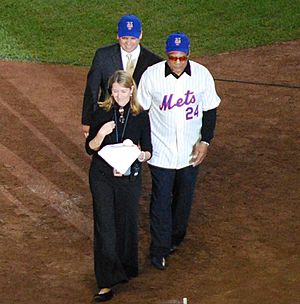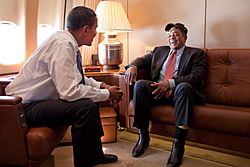Willie Mays facts for kids
Quick facts for kids Willie Mays |
|||
|---|---|---|---|
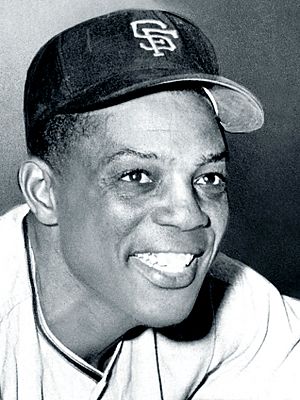
Mays with the San Francisco Giants in 1961
|
|||
| Center fielder | |||
| Born: May 6, 1931 Westfield, Alabama, U.S. |
|||
| Died: June 18, 2024 (aged 93) Palo Alto, California, U.S. |
|||
|
|||
| Professional debut | |||
| NAL: May 25, 1948, for the Birmingham Black Barons | |||
| NL: May 25, 1951, for the New York Giants | |||
| Last appearance | |||
| September 9, 1973, for the New York Mets | |||
| MLB statistics | |||
| Batting average | .301 | ||
| Hits | 3,293 | ||
| Home runs | 660 | ||
| Runs batted in | 1,909 | ||
| Teams | |||
Negro Leagues
Major League Baseball
|
|||
| Career highlights and awards | |||
|
|||
| Induction | 1979 | ||
| Vote | 94.7% (first ballot) | ||
Willie Howard Mays Jr. (born May 6, 1931 – died June 18, 2024), known as "the Say Hey Kid", was an American professional baseball player. He played as a center fielder. Many people think Mays was one of the greatest baseball players ever. He played in the National League (NL) from 1951 to 1973. He played for the New York / San Francisco Giants and the New York Mets.
Willie Mays was an amazing all-around athlete. He started his career in the Negro American League in 1948 with the Birmingham Black Barons. The Giants signed him in 1950 after he finished high school. He quickly became a star in Major League Baseball (MLB). He won the Rookie of the Year Award in 1951. In 1954, he helped the Giants win the World Series. He made one of the most famous catches in baseball history during that series, known as "The Catch". After the Giants moved to San Francisco, Mays continued to shine. He won another MVP Award in 1965. He finished his career back in New York with the New York Mets in 1973.
Mays was an All-Star 24 times, which is one of the most in history. He led the NL in home runs four times. He also led the league in stolen bases four times. He was the first NL player to hit 30 home runs and steal 30 bases in the same season. He was also the first player to reach 300 home runs and 300 stolen bases. Mays was also a fantastic defensive player. He won 12 Gold Glove Awards in a row, which is still a record for outfielders. He was elected to the Baseball Hall of Fame in 1979.
Contents
- Early Life and Baseball Start
- Professional Baseball Career
- Player Style and Skills
- Legacy and Impact
- Cultural Impact
- After Playing Baseball
- Special Honors and Appearances
- Personal Life and Passing
- See also
Early Life and Baseball Start
Willie Howard Mays Jr. was born on May 6, 1931, in Westfield, Alabama. His father, Cat Mays, was a good baseball player. His mother, Annie Satterwhite, was a talented athlete in high school. Willie was called "Buck" by his family and friends.
Willie's parents separated when he was three. His father and two aunts raised him. His father introduced him to baseball very early. Willie's favorite players were Joe DiMaggio, Ted Williams, and Stan Musial. Mays played many sports in high school, including basketball and football.
Professional Baseball Career
Starting in the Negro and Minor Leagues
Mays began his professional baseball journey in 1948. He played for the Chattanooga Choo-Choos, a minor league team in the Negro leagues. Later that year, he joined the Birmingham Black Barons in the Negro American League. He was known for his great fielding and base running.
Many major league teams wanted to sign Mays. The Giants signed him for $4,000 in 1950. He played well in the minor leagues before joining the Giants.
Becoming a Star with the Giants
Rookie of the Year Award
The Giants called Mays up to the major leagues on May 24, 1951. He was nervous at first. Giants manager Leo Durocher told him to join the team. Around this time, Mays got his famous nickname: "The Say Hey Kid".
Mays played his first MLB game on May 25. He didn't get any hits in his first 12 tries. But in his 13th try, he hit his first home run on May 28. He won the National League (NL) Rookie of the Year Award that season. The Giants had an amazing comeback that year. They caught up to the Dodgers and won the NL pennant. Mays' great fielding and strong throwing helped a lot.
The Giants played the New York Yankees in the 1951 World Series. Mays' childhood hero, Joe DiMaggio, was on the Yankees. The Giants lost the series.
Serving in the U.S. Army
After the 1951 season, Mays was drafted into the United States Army for the Korean War. He missed about two years of baseball. He played on military baseball teams during his service. He learned the "basket catch" technique while in the Army. He returned to the Giants in 1954.
World Series Champion and NL MVP
Mays had a fantastic 1954 season. He won the NL Most Valuable Player Award. He also helped the Giants win the 1954 World Series. This series is famous for "The Catch". In Game 1, Mays made an incredible over-the-shoulder running catch. This play saved runs and helped the Giants win that game. Many people consider it one of the greatest plays in baseball history.
In 1955, Mays started stealing more bases. He led the league with 51 home runs. He finished third in the NL MVP voting.
New Manager and Gold Gloves
In 1956, Mays became the second player ever to join the 30–30 club. This means he hit 30 home runs and stole 30 bases in the same season. In 1957, the Gold Glove Awards were created. Mays won the first of 12 straight Gold Gloves for his amazing defense in center field. He was also the second player to join the 20–20–20 club (20 doubles, 20 triples, 20 home runs) and steal at least 20 bases.
Moving to San Francisco
The Giants moved to San Francisco after the 1957 season. Mays was still a top player. In 1958, he almost won the NL batting title. He hit .347, which was his career high. In 1959, Mays signed a contract for $75,000, making him the highest-paid player in baseball. He led the league in stolen bases for the fourth year in a row.
In 1960, the Giants moved into their new stadium, Candlestick Park. The winds there made hitting home runs tricky. Mays learned how to play the stadium well. In 1961, Mays had one of his best games. On April 30, he hit four home runs in one game. He finished the season with 40 home runs.
The 1962 Pennant Race
Mays continued to play at a very high level. In 1962, he led the team in many offensive stats. He hit 49 home runs and had 141 RBIs. The Giants tied with the Dodgers for first place. They played a three-game playoff series. Mays helped the Giants win Game 3, sending them to the 1962 World Series.
In the World Series, the Giants played the Yankees. The series went to Game 7. The Yankees won a very close game 1–0. This was Mays' last World Series appearance as a Giant.
Record Contract and Second MVP
Before the 1963 season, Mays signed a record-setting contract for $105,000 per season. In 1965, Mays had one of his best years. He hit his 500th career home run on September 13. He became only the fifth player to reach this mark. Mays won his second MVP award in 1965. He hit a career-high 52 home runs. He also led the NL in on-base percentage and slugging percentage.
In 1966, Mays tied Mel Ott's NL record of 511 home runs. He then set a new record on May 4. By the end of the season, only Babe Ruth had hit more home runs than Mays.
Player of the Decade
The Sporting News named Mays the "Player of the Decade" for the 1960s. On July 18, 1970, Mays got his 3,000th hit. He became only the tenth player to reach this milestone. He played 139 games that year, batting .291 with 28 home runs.
In 1971, Mays played 48 games at first base, though center field was still his main position. He had a strong start to the season. The Giants won the NL West and made the playoffs. Mays was honored with the first Roberto Clemente Award after the season.
Joining the New York Mets
On May 11, 1972, Mays was traded to the New York Mets. He was still very popular in New York. In his Mets debut on May 14, he hit a home run against his old team, the Giants. The fans at Shea Stadium cheered loudly. Mays played 88 games for the Mets in 1972.
In 1973, Mays' speed and arm were not as strong as before. He still made the All-Star team. The Mets won the NL East. On August 17, 1973, Mays hit his final (660th) home run. He announced his retirement on September 9, 1973. He said, "Baseball and me, we had what you might call a love affair." The Mets honored him on Willie Mays Night. He played his last game in the 1973 World Series, which the Mets lost.
All-Star Games
Mays played in 24 All-Star Games. This ties him for the second-most appearances ever. He took the game very seriously. In the 1963 All-Star Game, he made an amazing catch. He snagged his foot under a wire fence while catching a long fly ball. The NL won, and Mays was named the All-Star Game MVP. He won the award again in 1968.
Mays holds several All-Star Game records. He has the most at bats, hits, runs scored, and stolen bases. Ted Williams once said, "They invented the All-Star Game for Willie Mays."
Barnstorming Tours
Early in his career, Mays often went on "barnstorming" tours. These were exhibition games played by star players in different cities after the regular season. Mays led his own team, Willie Mays' All-Stars, from 1955 to 1958. They played in the southern United States, Mexico, Puerto Rico, and the Dominican Republic. These tours helped bring baseball to more fans.
Player Style and Skills
Mays had a unique batting style. He stood with his legs apart and held the bat high. He believed his movements added power to his swing. Branch Rickey said Mays swung with more power and bat speed than any other player.
Defensively, Mays was one of the best outfielders ever. He won 12 Gold Gloves. His famous "basket catch" was stylish and effective. He would hold his glove around his belly with his palm up, letting the ball fall right in. His range in the outfield was huge, and his arm was very strong. He could make amazing throws from anywhere.
Mays' flashy style came from his time in the Negro leagues. He said, "We were all entertainers." He sometimes made catches look harder than they were to excite the fans. He also wore his cap a size too big so it would fly off when he ran. Even though he was a powerful hitter, he was also a daring base runner.
Legacy and Impact
 |
|
| Willie Mays's number 24 was retired by the San Francisco Giants in 1972. |
 |
|
| Willie Mays's number 24 was retired by the New York Mets in 2022. |
On January 23, 1979, Mays was elected to the Baseball Hall of Fame. He was chosen in his very first year of eligibility. In his speech, Mays talked about his love for baseball.
In 1999, The Sporting News ranked Mays second on its list of the "100 Greatest Baseball Players". Only Babe Ruth was ranked higher. Fans also voted him onto the Major League Baseball All-Century Team. Many other players and coaches called him the greatest player they ever saw. Roberto Clemente said, "To me, Willie Mays is the greatest who ever played."
Mays holds many impressive baseball records. He ranks sixth all-time in home runs with 660. His 2,062 runs scored rank seventh. His 1,903 runs batted in rank 12th. He had 3,293 hits, which is the 12th-most ever. He also played 2,992 games, ranking ninth all-time. He stole 338 bases. His 12 Gold Glove Awards are a record for outfielders. He is also the all-time leader in outfield putouts.
Baseball experts often say Mays was the best center fielder of all time. He was known as a "five-tool player" because he could hit for average, hit for power, run fast, throw well, and field well.
Cultural Impact
Mays, along with Mickey Mantle and Duke Snider, was one of three famous center fielders in New York in the 1950s. Fans often debated who was the best.
Mays was very popular in Harlem, a neighborhood in New York City. He often played stickball with kids in the streets. He could hit the rubber ball "five sewers" far, which was almost 450 feet!
Unlike some other black athletes, Mays usually kept quiet about racial issues. He believed his job was to play baseball. He said, "I'm a ballplayer. I can do best for my people by doing what I do best."
After Playing Baseball
After retiring as a player, Mays worked for the New York Mets as a hitting instructor. Later, he took a job at a casino. The Baseball Commissioner at the time, Bowie Kuhn, said he couldn't be involved in both baseball and a casino. So, Mays left his Mets job and was banned from baseball for a short time. In 1985, a new commissioner, Peter Ueberroth, allowed Mays to return to baseball.
Mays became a special assistant for the Giants in 1986. He signed a lifetime contract with the team in 1993. He helped get support for building Oracle Park, the Giants' new stadium. The Giants retired Mays' number 24 in 1972. Their stadium is located at 24 Willie Mays Plaza. There is also a nine-foot-tall statue of Mays outside the main entrance. In 2022, the Mets also retired Mays' number 24.
Special Honors and Appearances
Mays met with several U.S. Presidents. He met Queen Elizabeth II at the White House in 1976. In 2015, President Barack Obama honored Mays with the Presidential Medal of Freedom, one of the highest awards a civilian can receive.
In 2017, Major League Baseball renamed the World Series MVP Award the Willie Mays World Series MVP Award. Mays also received honorary degrees from several universities.
Mays appeared in many films and TV shows. He was a mystery guest on What's My Line? and appeared on The Donna Reed Show. He also voiced himself in an animated special. The comic strip Peanuts often mentioned Mays.
Many popular songs mention Willie Mays. The Treniers recorded "Say Hey (The Willie Mays Song)" in 1954. John Fogerty's song "Centerfield" and Terry Cashman's "Talkin' Baseball (Willie, Mickey & The Duke)" also feature Mays.
Personal Life and Passing
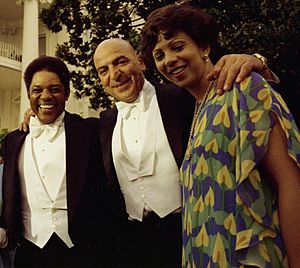
Mays married Marghuerite Wendell Chapman in 1956. They adopted a baby boy named Michael in 1959. They later divorced. Eight years later, Mays married Mae Louise Allen. She was diagnosed with Alzheimer's disease in 1997, and Mays cared for her until she passed away in 2013.
Willie Mays was the godfather of Barry Bonds, another famous baseball player. Barry's father, Bobby Bonds, was a friend and teammate of Mays.
Mays had Glaucoma, which affected his eyesight later in life. He passed away on June 18, 2024, from heart failure in Palo Alto, California.
See also
 In Spanish: Willie Mays para niños
In Spanish: Willie Mays para niños
- List of Negro league baseball players who played in Major League Baseball
- List of Major League Baseball career home run leaders
- List of Major League Baseball career runs scored leaders
- List of Major League Baseball career runs batted in leaders
- List of Major League Baseball career doubles leaders
- List of Major League Baseball career putouts as a center fielder leaders
- List of Major League Baseball career putouts as an outfielder leaders
- List of Major League Baseball career triples leaders
- List of Major League Baseball annual runs scored leaders
- List of Major League Baseball annual triples leaders
- List of Major League Baseball single-game home run leaders
- List of Major League Baseball retired numbers
- Major League Baseball titles leaders


